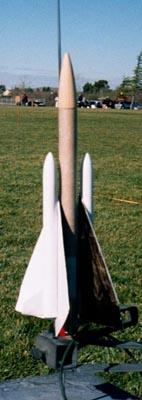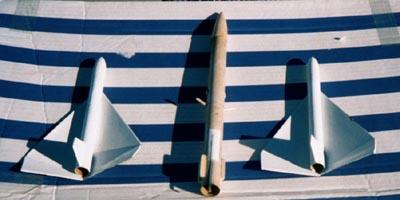| Construction Rating: | starstarstarstar_borderstar_border |
| Flight Rating: | starstarstarstarstar |
| Overall Rating: | starstarstarstarstar_border |
| Manufacturer: | Estes  |
Brief:
 _Space Twins_ is (are?) a nifty rocket that spawned a bunch of imitators through the years, ranging from the MPC Lunar Patrol to Estes' own "A.R.V. Condor." It features a finless central core that is recovered by parachute, plus two "parasite" gliders that detach on ejection. The _Space Twins_ plans were distributed by Estes Industries as part of their "Free Plan" program. The plans may be found at: http://www.dars.org/jimz/eirp_41.htm.
_Space Twins_ is (are?) a nifty rocket that spawned a bunch of imitators through the years, ranging from the MPC Lunar Patrol to Estes' own "A.R.V. Condor." It features a finless central core that is recovered by parachute, plus two "parasite" gliders that detach on ejection. The _Space Twins_ plans were distributed by Estes Industries as part of their "Free Plan" program. The plans may be found at: http://www.dars.org/jimz/eirp_41.htm.
Construction:
The _Space Twins_ gliders and booster-core are made from very conventional materials. The booster-core is based on the BT-20 body tube. It's basically a finless, parachute-recovered model rocket. It has two unusual features: A set of "fenders" made from scraps of balsa, and two pegs, for mounting the gliders, made from 1/8" dowels. The dowels are glued into holes drilled in the body tube; a tube coupler is glued into the mounting spot first, to reinforce the dowel/body tube joint. The gliders are lengths of BT-5 tubing, with balsa nose cones and 1/16" balsa wings and rudders. Short lengths of 1/8" launch lug are mounted on the "ventral" surface of the gliders, just to the rear of the nose cone; these fit over the booster-core's dowels. While the plans specify balsa cones and lead weights, you should have no trouble using plastic cones and clay nose weight.
The gliders and boosters went together fairly easily. The instructions are fairly dense, and might be a little daunting to those unfamiliar with early rocket construction techniques. As with many from-plan kits, building the Space Twins requires you to cut the fins and other parts from balsa sheets, using templates cut from the plans. In order to produce sturdier templates, I reprinted the plans on the heaviest cardstock that my printer would accept. There were two tricky bits: Mounting the dowels into the booster and inserting the launch lugs into the gliders. This requires cutting both lugs and dowels at fairly exact angles. Be really patient, "measure twice, cut once," and test fit the parts first. If you do things right, the gliders should slip onto the dowels easily, and stay on and straight until the model is turned upside down and "rapped" in the rear. I test-flew the gliders by tossing them around my living room. They glided really well; I did have to adjust the elevons on one, to get a less-steep glide; I accomplished this by holding the joint over a incandescent light bulb until the glue softened a bit.
Finishing:
The _Space Twins_ plans don't include a standard paint scheme, decals, etc. I decided to use dope to finish my _Space Twins_. Dope is hard to work with, and requires a very carefully sanded and filled surface, but when done well results in a nice, slick, durable finish. I used balsa fillercoat on both gliders and core, and did lots of sanding to eliminate balsa grain and generally smooth things out. At this time, the finish isn't complete. The core and gliders are overall white, with the underside of the glider wings painted black. I hope to paint each glider with a unique, bright color; the booster core will be white with a black nose.
Construction Rating: 3 out of 5
 Flight:
Flight:
The _Space Twins_ plans don't have a suggested motor list. I decided to test fly it with Quest A6-4 motor, then follow up with a B4-4 motor. I decided that the longer delay on these motors would result in ejection happening "on the way down," giving the gliders a better chance of being knocked free. Flight prep is really easy. The booster is prepped just like a normal rocket. I placed the gliders on the core after I'd slid it onto the launch rod and hooked up the igniter. The _Space Twins_ flew GREAT. The boost was very straight. Altitude reached was moderate (perhaps 200' on the A6-4); the model had arced over and was starting to "plummet" downwards when the ejection charge went off.
Recovery:
On my initial flight, the booster core's parachute didn't unfurl fully. However, it was light enough that it landed without damage. I think a streamer would do as well as a parachute. The glider "twins" separated cleanly and began circling downward in a fast, spiral trajectory. The crowd seemed to enjoy the "show" they put on. They landed within about about five feet of each other, about 50' from the launch pad.
Flight Rating: 5 out of 5
Summary:
I flew the _Space Twins_ twice more on the day of its inaugural launch. The second flight, with an A8-5, was very similar to the first, although the booster parachute deployed fine this time. Once more, the gliders separated cleanly, flew well, and landed close to each other. I tried a B4-4 next. It flew a lot higher, and the gliders had a lot more time to swoop around. But, as before, the gliders landed quite close to each other. I really liked that!
Overall Rating: 4 out of 5
Sponsored Ads
 |
 |











